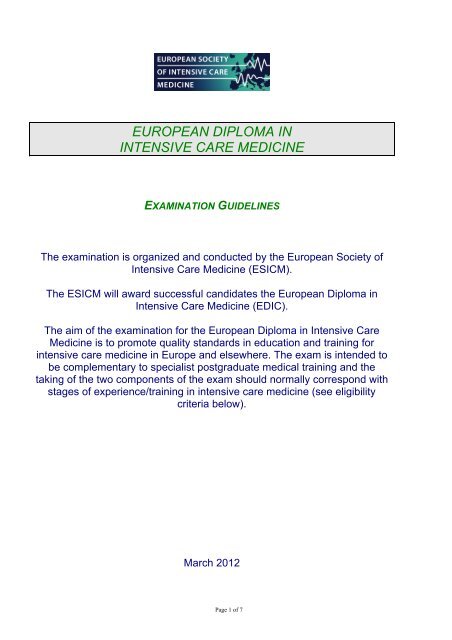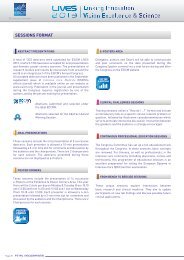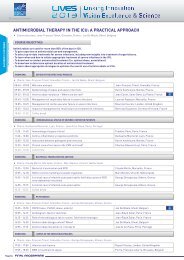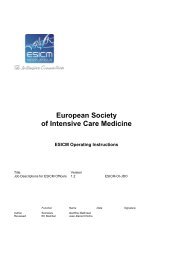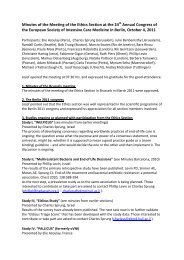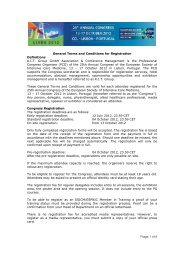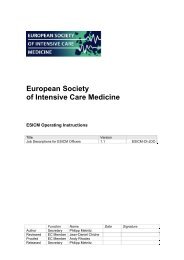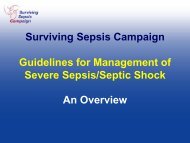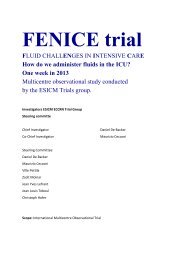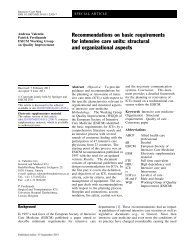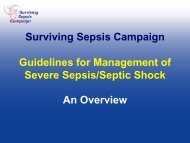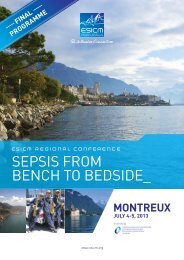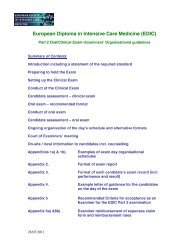european diploma in intensive care medicine examination ... - ESICM
european diploma in intensive care medicine examination ... - ESICM
european diploma in intensive care medicine examination ... - ESICM
Create successful ePaper yourself
Turn your PDF publications into a flip-book with our unique Google optimized e-Paper software.
EUROPEAN DIPLOMA IN<br />
INTENSIVE CARE MEDICINE<br />
EXAMINATION GUIDELINES<br />
The exam<strong>in</strong>ation is organized and conducted by the European Society of<br />
Intensive Care Medic<strong>in</strong>e (<strong>ESICM</strong>).<br />
The <strong>ESICM</strong> will award successful candidates the European Diploma <strong>in</strong><br />
Intensive Care Medic<strong>in</strong>e (EDIC).<br />
The aim of the exam<strong>in</strong>ation for the European Diploma <strong>in</strong> Intensive Care<br />
Medic<strong>in</strong>e is to promote quality standards <strong>in</strong> education and tra<strong>in</strong><strong>in</strong>g for<br />
<strong>in</strong>tensive <strong>care</strong> medic<strong>in</strong>e <strong>in</strong> Europe and elsewhere. The exam is <strong>in</strong>tended to<br />
be complementary to specialist postgraduate medical tra<strong>in</strong><strong>in</strong>g and the<br />
tak<strong>in</strong>g of the two components of the exam should normally correspond with<br />
stages of experience/tra<strong>in</strong><strong>in</strong>g <strong>in</strong> <strong>in</strong>tensive <strong>care</strong> medic<strong>in</strong>e (see eligibility<br />
criteria below).<br />
March 2012<br />
Page 1 of 7
ELIGIBILITY/QUALIFICATIONS<br />
EDIC PART I: WRITTEN EXAMINATION<br />
Criteria for entry Required documentation<br />
1. Fully registered Medical Doctor (i.e. <strong>in</strong>ternship<br />
completed). Candidates must be <strong>in</strong> good stand<strong>in</strong>g with their<br />
national medical registration authorities.<br />
2. Entry <strong>in</strong>to a national tra<strong>in</strong><strong>in</strong>g programme <strong>in</strong> a primary<br />
specialty. This may <strong>in</strong>clude Anaesthesiology,<br />
General/Internal Medic<strong>in</strong>e (and other medical specialities),<br />
General Surgery (and other surgical specialities), Accident &<br />
Emergency Medic<strong>in</strong>e, Paediatrics, or Intensive Care<br />
Medic<strong>in</strong>e if a primary speciality.<br />
3. Entry <strong>in</strong>to a national tra<strong>in</strong><strong>in</strong>g programme <strong>in</strong> <strong>in</strong>tensive <strong>care</strong><br />
medic<strong>in</strong>e or satisfactory completion of 12 months<br />
tra<strong>in</strong><strong>in</strong>g/experience <strong>in</strong> ICM**, of which not more than six<br />
months may <strong>in</strong>clude complementary tra<strong>in</strong><strong>in</strong>g.<br />
Complementary tra<strong>in</strong><strong>in</strong>g entails tra<strong>in</strong><strong>in</strong>g <strong>in</strong> the acute and<br />
emergency medical <strong>care</strong> of patients other than <strong>in</strong> the<br />
tra<strong>in</strong>ee’s primary speciality.<br />
** Intensive Care Medic<strong>in</strong>e tra<strong>in</strong><strong>in</strong>g/experience should be undertaken <strong>in</strong><br />
modules of dedicated, full-time, supervised tra<strong>in</strong><strong>in</strong>g / experience <strong>in</strong> Intensive<br />
Care Medic<strong>in</strong>e<br />
Specialists (Consultants/Attend<strong>in</strong>g) may take the EDIC if<br />
they have a regular, substantive day-time and emergency<br />
call commitment to <strong>in</strong>tensive/critical <strong>care</strong> medic<strong>in</strong>e.<br />
You must provide evidence of your specialty and support for<br />
your application<br />
EDIC PART 2: ORAL/CLINICAL EXAMINATION<br />
Page 2 of 7<br />
Copy of University-awarded medical degree<br />
Letter of confirmation from national or regional primary<br />
specialty Tra<strong>in</strong><strong>in</strong>g Authority<br />
(e.g. College or Society)<br />
Documents/letter confirm<strong>in</strong>g your tra<strong>in</strong><strong>in</strong>g <strong>in</strong> ICM or<br />
completion of ICM tra<strong>in</strong><strong>in</strong>g programme<br />
Criteria for entry Required documentation<br />
1. Successful completion of EDIC Part I<br />
2. 24 months of tra<strong>in</strong><strong>in</strong>g/experience <strong>in</strong> ICM**, of which not<br />
more than 6 months may <strong>in</strong>clude ‘complementary tra<strong>in</strong><strong>in</strong>g’<br />
(see above).<br />
To m<strong>in</strong>imise the failure rate and to accommodate requests<br />
for candidates from outside Europe, it is recommended that<br />
candidates should acquire a thorough understand<strong>in</strong>g of<br />
European ICM practice. It is recommended that this is best<br />
facilitated by work<strong>in</strong>g <strong>in</strong> an academic European ICU for a<br />
period of at least six months. If your application form does<br />
not specify tra<strong>in</strong><strong>in</strong>g with<strong>in</strong> a European ICU, you may be<br />
requested to provide documentation confirm<strong>in</strong>g such tra<strong>in</strong><strong>in</strong>g<br />
/ experience.<br />
** Intensive Care Medic<strong>in</strong>e tra<strong>in</strong><strong>in</strong>g/experience should be undertaken <strong>in</strong><br />
modules of dedicated, full-time, supervised tra<strong>in</strong><strong>in</strong>g / experience <strong>in</strong> Intensive<br />
Care Medic<strong>in</strong>e<br />
The <strong>diploma</strong> is awarded to those who have successfully:<br />
♦ passed EDIC Parts I and 2<br />
♦ completed their primary base specialty ***<br />
AWARDING OF EDIC DIPLOMA<br />
Contact details for:<br />
♦ If you are <strong>in</strong> ICM tra<strong>in</strong><strong>in</strong>g: Tra<strong>in</strong><strong>in</strong>g Authority,<br />
supervisor or Head of tra<strong>in</strong><strong>in</strong>g<br />
♦ If you have completed your ICM tra<strong>in</strong><strong>in</strong>g: Head of<br />
Department or Head of Tra<strong>in</strong><strong>in</strong>g Programme or<br />
other representative who can attest to your hav<strong>in</strong>g<br />
completed ICM tra<strong>in</strong><strong>in</strong>g<br />
Copy of university-awarded medical degree and current<br />
certificate of full medical registration<br />
Documents/letter confirm<strong>in</strong>g your tra<strong>in</strong><strong>in</strong>g <strong>in</strong> ICM or<br />
completion of ICM tra<strong>in</strong><strong>in</strong>g programme (to complement<br />
what you submitted for EDIC Part I)<br />
Copy of primary speciality certification, if completed<br />
Contact details for:<br />
♦ If you are <strong>in</strong> ICM tra<strong>in</strong><strong>in</strong>g: Tra<strong>in</strong><strong>in</strong>g Authority,<br />
supervisor or Head of tra<strong>in</strong><strong>in</strong>g<br />
♦ If you have completed your ICM tra<strong>in</strong><strong>in</strong>g: Head of<br />
Department or Head of Tra<strong>in</strong><strong>in</strong>g Programme or<br />
other representative who can attest to your hav<strong>in</strong>g<br />
completed ICM tra<strong>in</strong><strong>in</strong>g<br />
*** If you have passed parts I and 2 but not yet completed your primary specialty, please send proof of completion of this specialty. Only upon reception<br />
of this document will you be awarded EDIC.
,<br />
The EDIC is a two part exam<strong>in</strong>ation: Part 1 is a multiple choice questionnaire written exam<strong>in</strong>ation and Part 2 is a<br />
cl<strong>in</strong>ical / oral exam<strong>in</strong>ation.<br />
PART I WRITTEN EXAMINATION<br />
EDIC part I exam<strong>in</strong>ation is a multiple choice written exam<strong>in</strong>ation <strong>in</strong> English. There are 100 multiple choice questions<br />
(MCQs) and each question trunk will have either four or five stems.<br />
The paper conta<strong>in</strong>s two types of MCQ questions:<br />
♦ 50 type A questions: of the five options (A to E) available, only one answer is correct<br />
♦ 50 type K questions. The questions requires an <strong>in</strong>dividual answer T (true) or F (false), to each of the four statements<br />
A to D <strong>in</strong> the question.<br />
EXAMPLE OF TYPE A QUESTIONS<br />
Which ONE of the follow<strong>in</strong>g statements about vasoactive drugs is FALSE:<br />
A Adrenal<strong>in</strong>e (ep<strong>in</strong>ephr<strong>in</strong>e) has alpha and beta receptor agonist activity<br />
B Noradrenal<strong>in</strong>e (norep<strong>in</strong>ephr<strong>in</strong>e) is a vasoconstrictor<br />
C Dopam<strong>in</strong>e acts on renal dopam<strong>in</strong>e receptors<br />
D Isoprenal<strong>in</strong>e (isoproterenol) is a systemic and pulmonary vasodilator<br />
E Dopam<strong>in</strong>e has a specific renal protective action <strong>in</strong> critical <strong>care</strong> patients at risk of renal<br />
failure<br />
The required (correct) answer is marked here with an X.<br />
Dur<strong>in</strong>g the exam, you will be required to mark your answer <strong>in</strong> the question booklet AND <strong>in</strong>dicat<strong>in</strong>g the correct answer on your<br />
answer sheet.<br />
On the answer sheet, you will need to designate the correct answer with a stroke <strong>in</strong> the box correspond<strong>in</strong>g with the<br />
correct answer: The boxes correspond<strong>in</strong>g with the <strong>in</strong>correct options should be left blank as shown below.<br />
A<br />
B<br />
C<br />
D<br />
E<br />
⎜⎜<br />
EXAMPLE OF TYPE K QUESTIONS<br />
Appropriate, immediate, <strong>in</strong>itial antimicrobial therapy (after cultures have been taken) for the follow<strong>in</strong>g<br />
acute <strong>in</strong>fections, <strong>in</strong> adult patients, is:<br />
A Cefotaxime 2G 4hrly (or equivalent) IV for men<strong>in</strong>gitis T<br />
B L<strong>in</strong>ezolid 600mg bd IV for suspected pseudomonas pneumonia F<br />
C Vancomyc<strong>in</strong> 1G bd IV for peritonitis F<br />
D Metronidazole 400mg 8hrly NG for suspected Cl. Difficile enterocolitis T<br />
For these questions you must also note your answers <strong>in</strong> the question booklet AND on the answer sheet.<br />
In the question booklet note your answers with a T (True) or F (False) next to the question.<br />
On the answer sheet a T (True) response is <strong>in</strong>dicated by a + (plus) sign and a F (False) is <strong>in</strong>dicated by a – (m<strong>in</strong>us)<br />
sign. On the answer sheet, you are asked to <strong>in</strong>dicate your chosen answer by over-writ<strong>in</strong>g with a stroke on the (+ =<br />
true) and (- = false) as follows (See column B).<br />
Page 3 of 7<br />
X
A B<br />
+ -<br />
+ -<br />
+ -<br />
+ -<br />
⎜⎜ -<br />
+ ⎜⎜<br />
+ ⎜⎜<br />
⎜⎜ -<br />
There are no negative mark<strong>in</strong>gs.<br />
Questions are drawn from the entire spectrum of <strong>in</strong>tensive <strong>care</strong> medic<strong>in</strong>e, <strong>in</strong>clud<strong>in</strong>g basic medical sciences, pathophysiology<br />
of relevant diseases, <strong>in</strong>terpretation of diagnostic data, therapeutics/toxicology, ethics and all aspects of<br />
cl<strong>in</strong>ical ICM practice.<br />
The <strong>ESICM</strong> will be offer<strong>in</strong>g registered candidates (who have paid their exam fee) to access a series of sample<br />
MCQ questions used <strong>in</strong> pervious EDIC-1 exams. Candidates will get an <strong>in</strong>dividual time-limited password and be<br />
able to answer questions onl<strong>in</strong>e, with <strong>in</strong>stant feedback on their own performance. In addition to the tra<strong>in</strong><strong>in</strong>g<br />
experience this will give a very good impression about the difficulty to expect dur<strong>in</strong>g the exam, and how different<br />
k<strong>in</strong>d of questions (A and K) can look like.<br />
EVALUATION OF THE EXAM AND INDIVIDUAL ANSWERS<br />
For a correct answer type A question 1 po<strong>in</strong>t is given, for a wrong or a blank answer 0 po<strong>in</strong>t. For a type K question,<br />
1 po<strong>in</strong>t is given for 4 correct answers, 0.5 po<strong>in</strong>t for 3 out of 4 correct answers and 0 po<strong>in</strong>t for less then 3 correct<br />
answers. The pass mark is fixed each year based on a calculation us<strong>in</strong>g the mean value and SD. (mean value of<br />
the cohort, - 0.6 SD).<br />
Each year the <strong>ESICM</strong> EDIC committee along with SGI (the Swiss society of Intensive Care Medic<strong>in</strong>e) and IML<br />
evaluates the exam, and generates statistics on each question. Doubtful and poorly performed questions are<br />
usually removed before the f<strong>in</strong>al evaluation of the exam.<br />
The Angoff method procedure<br />
The Modified Angoff procedure is used to determ<strong>in</strong>e the <strong>in</strong>itial pass<strong>in</strong>g score for an exam<strong>in</strong>ation used to certify or<br />
license practitioners. It is one of the most popular procedures for sett<strong>in</strong>g a criterion-referenced pass<strong>in</strong>g po<strong>in</strong>t. It is<br />
not a norm-referenced method, when a candidate’s pass or fail status is determ<strong>in</strong>ed by his or her performance <strong>in</strong><br />
relation to other candidates. Us<strong>in</strong>g the Angoff procedure, once the pass<strong>in</strong>g po<strong>in</strong>t is determ<strong>in</strong>ed, a candidate’s<br />
pass/fail performance is established <strong>in</strong>dependently of the group who sat for the exam. Candidates are judged by<br />
compar<strong>in</strong>g their performance to an absolute standard, not to other candidates. Theoretically, all candidates can<br />
pass or all can fail.<br />
The Angoff method relies on subject-matter experts, <strong>in</strong> our case the EDIC subcommittee, who exam<strong>in</strong>e the content<br />
of each test question (item) and then predict how many of 100 “m<strong>in</strong>imally competent practitioner” are likely to<br />
answer the item correctly. The average of the judges’ predictions for a test question becomes its predicted difficulty.<br />
The sum of the predicted difficulty values for each item averaged across the judges and items on a test is the<br />
recommended Angoff cut score. {Pass<strong>in</strong>g Scores: A Manual for Sett<strong>in</strong>g Standards of Performance on Educational<br />
and Occupational Tests (1982). Liv<strong>in</strong>gston, S.A., and Zieky, M.J.}<br />
Here how the EDIC subcommittee members (EDIC-panel), 9 experienced <strong>in</strong>tensivists of 6 different European<br />
countries, assessed the absolute standard for EDIC part 1:<br />
All members of the EDIC-panel were properly tra<strong>in</strong>ed on how to use the Angoff Method and <strong>in</strong>formed on the test’s<br />
purpose. Then each EDIC-panel member <strong>in</strong>dividually rated each of the 2010 and 2011 exam MCQs based on how<br />
many of 100 “m<strong>in</strong>imally competent practitioners” would answer the item correctly or <strong>in</strong>correctly. A “m<strong>in</strong>imally<br />
competent practitioner” has been def<strong>in</strong>ed as a person with sufficient knowledge to work <strong>in</strong> the ICU <strong>in</strong>dependently<br />
without jeopardiz<strong>in</strong>g patient life. Once this first round of rat<strong>in</strong>gs had been conducted, EDIC-panellists met and get<br />
access to the rat<strong>in</strong>gs of the other panellists so that they could compare what they determ<strong>in</strong>ed about a particular<br />
item. Then, EDIC-panellists were asked to rate the items aga<strong>in</strong> for a second round. The second round of rat<strong>in</strong>g<br />
gives to EDIC-panellists the opportunity to review their <strong>in</strong>itial rat<strong>in</strong>g of an item and decide whether or not they might<br />
like to change their decision based on the expert judgments of the other panellists. This second round of rat<strong>in</strong>gs<br />
was then averaged across the EDIC-panellists to determ<strong>in</strong>e the f<strong>in</strong>al cut score (absolute standard) for the EDIC<br />
part 1 exam. The cut score for the 2012 and future exams has so been fixed at 60, which means that 60% of the<br />
questions have to be answered correctly to pass the exam. Each year exam difficulty will be compared with the<br />
previous ones. If similar, then the same standard is applied. The absolute standard will be re-evaluated <strong>in</strong> 3-5 years<br />
time.<br />
Page 4 of 7
EXAM QUESTIONS – PATTERN & CONTENT<br />
The content bluepr<strong>in</strong>t which the exam questions follow is currently is broadly as follows:<br />
Bluepr<strong>in</strong>t N°. Bluepr<strong>in</strong>t Topic Comb<strong>in</strong>ed number of Type A & K<br />
questions<br />
1 Cardiovascular 12<br />
2 Respiratory 16<br />
3 Neuro-critical <strong>care</strong> 10<br />
4 Gastro Intest<strong>in</strong>al / nutritional 8<br />
5.1 Renal 4<br />
5.2 Urology, Obstetrics & Gynaecology 4<br />
6.1 Endocr<strong>in</strong>e & metabolic 4<br />
6.2 Bleed<strong>in</strong>g & Coagulation disorders 4<br />
6.3 Oncology 4<br />
7 Environmental Hazards, Poison<strong>in</strong>g & acute<br />
8<br />
pharmacology<br />
8 Severe Infection & Sepsis 10<br />
9 Surgery & trauma 6<br />
10.1 Ethics, Law & Quality Assurance 4<br />
10.3 Intensive Care management 4<br />
10.4 Transplantation 2<br />
Total 100<br />
The content bluepr<strong>in</strong>t is subject to changes each year.<br />
The questions are drawn from the entire spectrum of <strong>in</strong>tensive <strong>care</strong> medic<strong>in</strong>e and with<strong>in</strong> each section of the<br />
bluepr<strong>in</strong>t, components of the question relate to basic medical sciences, patho-physiology of relevant diseases,<br />
<strong>in</strong>terpretation of diagnostic data, therapeutics/toxicology, complications and any other aspect relevant to the cl<strong>in</strong>ical<br />
practice of Intensive Care Medic<strong>in</strong>e.<br />
The exam is under cont<strong>in</strong>uous review and the format may be changed without notice. Similarly, the requirements for<br />
the exam, its conduct, and the standards required, are all kept under review, and are subject to change.<br />
EXAM REGULATIONS<br />
♦ Three hours are allowed for the exam<strong>in</strong>ation. This is strictly applied.<br />
♦ Please check your candidate <strong>in</strong>formation on the question paper and answer sheet. Please complete the<br />
additional candidate <strong>in</strong>formation requested at the end of the question paper, and correct any <strong>in</strong>correct<br />
<strong>in</strong>formation.<br />
♦ The question paper and answer sheets are the only paper materials allowed on your desk.<br />
♦ No exam<strong>in</strong>ation aids are permitted e.g. calculator or dictionary.<br />
♦ All bags and belong<strong>in</strong>gs must be placed at the designated location.<br />
♦ Copy<strong>in</strong>g or cheat<strong>in</strong>g of any description will entail immediate disqualification. The decision will be at the discretion<br />
of the exam<strong>in</strong>ation supervisor.<br />
♦ Toilet breaks are only allowed if accompanied by an exam<strong>in</strong>er, and if the exam room is equipped with the<br />
facilities.<br />
♦ Mobile phones must be switched off.<br />
♦ The exam booklet and answer sheet must be filled <strong>in</strong> with a pencil (no pens).<br />
♦ The question paper and answer sheet must be signed and returned to the exam<strong>in</strong>ation supervisor at the end of<br />
the exam<strong>in</strong>ation.<br />
PART I EXAM RESULTS<br />
All candidates who have passed the Part I exam will be notified of their results by the <strong>ESICM</strong> adm<strong>in</strong>istrative office<br />
approximately 6 weeks after the exam. This time is necessary for the validation process.<br />
Candidates, who have failed the Part I exam, will be allowed to sit the exam aga<strong>in</strong> after 12 months, no earlier. A total of<br />
three attempts are allowed.<br />
PART 2: THE CLINICAL AND ORAL EXAMINATION<br />
The standard expected for Part 2 is that of a senior tra<strong>in</strong>ee near<strong>in</strong>g completion of specialist tra<strong>in</strong><strong>in</strong>g <strong>in</strong> ICM, and<br />
capable of safe, <strong>in</strong>dependent practice. Candidates should be able to communicate effectively and be capable of<br />
consult<strong>in</strong>g and draw<strong>in</strong>g appropriately on the fullness of multi-discipl<strong>in</strong>ary patient support. Some subspecialty<br />
knowledge is expected, <strong>in</strong>clud<strong>in</strong>g for example, some general aspects of paediatric, cardiac and transplant critical<br />
<strong>care</strong>.<br />
Page 5 of 7
To m<strong>in</strong>imise the failure rate and to accommodate requests for candidates from outside Europe, it is recommended<br />
that candidates should acquire a thorough understand<strong>in</strong>g of European ICM practice. It is recommended that this is<br />
best facilitated by work<strong>in</strong>g <strong>in</strong> an academic European ICU for a period of at least six months. If your application form<br />
does not specify tra<strong>in</strong><strong>in</strong>g with<strong>in</strong> a European ICU, you may be requested to provide documentation confirm<strong>in</strong>g such<br />
tra<strong>in</strong><strong>in</strong>g / experience.<br />
Only those candidates who have successfully passed Part 1 may take the Part 2 cl<strong>in</strong>ical/oral exam<strong>in</strong>ation. It is<br />
anticipated that it will usually be taken with<strong>in</strong> 24 months of pass<strong>in</strong>g Part 1, and no later than 4 years after pass<strong>in</strong>g<br />
Part 1 unless otherwise approved by the Exam<strong>in</strong>ations Subcommittee.<br />
The Part 2 should be conducted <strong>in</strong> English or <strong>in</strong> the language of the candidate or <strong>in</strong> another European language<br />
chosen by the candidate, subject to the availability of approved centre and exam<strong>in</strong>ers.<br />
ORGANISATION<br />
Location<br />
In European countries, a group of suitable, major hospital general Intensive Care Units are identified <strong>in</strong> conjunction<br />
with relevant Council members and the <strong>ESICM</strong> EDIC Exam<strong>in</strong>ations subcommittee. The <strong>ESICM</strong> Education Secretariat<br />
will announce locations available via the website (www.esicm.org)<br />
Exam frequency<br />
The Part 2 exam is held at least once annually <strong>in</strong> each European country if there are enough eligible candidates who<br />
have applied. Sessions are held either <strong>in</strong> May/June or October/November each year.<br />
EDIC panel of exam<strong>in</strong>ers<br />
In European countries, a panel of <strong>ESICM</strong> approved exam<strong>in</strong>ers is agreed upon with the advice of the relevant <strong>ESICM</strong><br />
Council member(s) and the panel is held by the <strong>ESICM</strong> Education Secretariat. The <strong>ESICM</strong> Council member for the<br />
country, whether or not he/she is an exam<strong>in</strong>er, takes an active role <strong>in</strong> the organization of the exam. At least one of<br />
the faculty of exam<strong>in</strong>ers at the exam should be board certified (or equivalent) <strong>in</strong> the primary specialty of the<br />
candidate.<br />
External exam<strong>in</strong>er<br />
Where possible and suitable, an external exam<strong>in</strong>er may be <strong>in</strong>vited usually from another European country with the<br />
prior agreement of the <strong>ESICM</strong> Exam<strong>in</strong>ations subcommittee. Externs provide reports to the <strong>ESICM</strong> (and local<br />
exam<strong>in</strong>ers) on the conduct of the exam<strong>in</strong>ation, with a view to the facilitation of Europe-wide harmonization of quality<br />
standards.<br />
CONDUCT OF THE (PART 2) EXAMINATION<br />
The exam will consist of cl<strong>in</strong>ical and oral (viva voce) components. It is anticipated that each candidate will have<br />
around two hours for the cl<strong>in</strong>ical and oral parts, <strong>in</strong>clud<strong>in</strong>g patient exam<strong>in</strong>ation and discussion with the exam<strong>in</strong>ers.<br />
The candidate will be observed by the exam<strong>in</strong>ers <strong>in</strong> the cl<strong>in</strong>ical environment while exam<strong>in</strong><strong>in</strong>g more than one patient.<br />
The cl<strong>in</strong>ical component: This should take between 60-90 m<strong>in</strong>utes. It is recommended that the candidate should see<br />
one major case (approximately half an hour of exam<strong>in</strong><strong>in</strong>g) and two to three m<strong>in</strong>or cases (10 to 15 m<strong>in</strong>utes of<br />
exam<strong>in</strong><strong>in</strong>g each, depend<strong>in</strong>g on whether two or three cases are chosen).<br />
Major case: This should preferably be a patient with a range of cl<strong>in</strong>ical problems, for example pneumonia, severe<br />
asthma, multiple trauma, post-surgical complications, sepsis, severe pancreatitis, multiple organ dysfunction or<br />
failure, acute lung <strong>in</strong>jury, ventilator dependence and wean<strong>in</strong>g difficulties, etc.<br />
M<strong>in</strong>or cases: Two or three cases may be appropriate. These may be ICU or non-ICU cases. They might for example<br />
focus on a cl<strong>in</strong>ical sign e.g. new cardiac bruit / other signs of endocarditis, equipment such as chest dra<strong>in</strong>s or an<br />
<strong>in</strong>tra-aortic balloon pump, or a specific cl<strong>in</strong>ical exam<strong>in</strong>ation e.g. bra<strong>in</strong> stem test<strong>in</strong>g. The candidate does not undertake<br />
practical procedures.<br />
The oral component: This should take approximately 30-40 m<strong>in</strong>utes and may be divided <strong>in</strong>to two separate sessions<br />
or performed as a s<strong>in</strong>gle session.<br />
CANDIDATE ASSESSMENT<br />
Cl<strong>in</strong>ical component<br />
The assessment, particularly <strong>in</strong> the major case should take account of:<br />
♦ How well a candidate is able to elicit cl<strong>in</strong>ical <strong>in</strong>formation which is accurate, relevant and comprehensive – with<strong>in</strong><br />
the constra<strong>in</strong>ts of the circumstances. This is primarily physical-exam<strong>in</strong>ation based, but <strong>in</strong>cludes <strong>in</strong>formation to be<br />
ga<strong>in</strong>ed from around the bedside, for example from the nurse, the case records, the ICU charts or <strong>in</strong>formation<br />
system, dra<strong>in</strong>age and other tubes, sputum collection conta<strong>in</strong>ers, mach<strong>in</strong>es and monitors.<br />
♦ The approach of the candidate to the patient <strong>in</strong> terms of professionalism, politeness, compassion, patient dignity<br />
and ethical probity.<br />
♦ The capacity of the candidate to complete a structured cl<strong>in</strong>ical exam<strong>in</strong>ation with due consideration for the staff<br />
and environment, e.g. show<strong>in</strong>g compliance with isolation and hand-wash<strong>in</strong>g procedures where applicable.<br />
♦ How well a candidate can <strong>in</strong>tegrate <strong>in</strong>formation, present it coherently, construct relevant differential diagnoses,<br />
make management evaluations and then suggest and discuss therapeutic options at a level of expertise<br />
appropriate for a specialist <strong>in</strong> Intensive/Critical Care Medic<strong>in</strong>e.<br />
Page 6 of 7
Oral component<br />
This component should test knowledge of practical scenarios that cannot easily be provided or tested <strong>in</strong> the cl<strong>in</strong>ical<br />
environment. This will <strong>in</strong>clude radiology images, electrocardiograms, biochemical results and blood gas estimations<br />
and patient equipment. Abstracted case histories may also be used to test, for example, approaches to ethical<br />
dilemmas.<br />
MARKING PROCESS<br />
The candidate will be assessed by the exam<strong>in</strong>ers for both the cl<strong>in</strong>ical and the oral components of the exam, and<br />
graded for each component us<strong>in</strong>g a numeric scale from 0 to 5 as <strong>in</strong>dicated below:<br />
Scale Grade<br />
0 Severe failure<br />
1 Failure<br />
2 Bare Fail<br />
3 Pass<br />
4 Good pass<br />
5 Excellent<br />
EXAM RESULTS<br />
All candidates who have successfully passed the Part 2 exam will be notified of their results by the <strong>ESICM</strong><br />
adm<strong>in</strong>istrative office. Upon completion of Part 2 of the exam, as well as completion of their base specialty prior, will<br />
candidates be awarded EDIC.<br />
Candidates who have failed the Part 2 exam are allowed two <strong>in</strong>itial attempts. If a candidate has failed on each of<br />
these 2 occasions, (s)he will be required to allow 12 month break for further tra<strong>in</strong><strong>in</strong>g and preparation before tak<strong>in</strong>g the<br />
Part 2 exam aga<strong>in</strong> – when two f<strong>in</strong>al attempts are allowed.<br />
EXAMINATION PREPARATION<br />
The follow<strong>in</strong>g educational resources are recommended for candidates prepar<strong>in</strong>g for the exam<strong>in</strong>ation<br />
♦ Local or national critical <strong>care</strong> medic<strong>in</strong>e education and tra<strong>in</strong><strong>in</strong>g opportunities especially those associated with<br />
tra<strong>in</strong><strong>in</strong>g programmes.<br />
♦ Guidel<strong>in</strong>es for tra<strong>in</strong><strong>in</strong>g <strong>in</strong> <strong>in</strong>tensive <strong>care</strong> medic<strong>in</strong>e. Intensive Care Medic<strong>in</strong>e 1994; 20: 80-81.<br />
♦ PACT (Patient-centred Acute Care Tra<strong>in</strong><strong>in</strong>g): the <strong>ESICM</strong> distance-learn<strong>in</strong>g multi-media programme for <strong>in</strong>tensive<br />
<strong>care</strong>.<br />
♦ Up-to-date cl<strong>in</strong>ical textbooks on <strong>in</strong>tensive/critical <strong>care</strong>.<br />
♦ Current research and review literature <strong>in</strong> journals such as Intensive Care Medic<strong>in</strong>e, Critical Care Medic<strong>in</strong>e and<br />
other major journals.<br />
♦ <strong>ESICM</strong> annual congresses of the <strong>ESICM</strong> and its postgraduate courses (www.esicm.org).<br />
♦ CoBaTrICE program of <strong>in</strong>tensive <strong>care</strong> competencies (www.cobatrice.org).<br />
♦ Further documentation is also found on the <strong>ESICM</strong> website (www.esicm.org).<br />
ADMINISTRATION<br />
Applications must be made prior the deadl<strong>in</strong>e us<strong>in</strong>g the appropriate application forms. Late or <strong>in</strong>complete applications<br />
will not be accepted. Application forms, exam dates and application deadl<strong>in</strong>es can be obta<strong>in</strong>ed via the <strong>ESICM</strong><br />
website (www.esicm.org).<br />
Candidates attend<strong>in</strong>g either Part 1 or Part 2 of the exam<strong>in</strong>ation may be asked to provide identification (passport or<br />
any other form <strong>in</strong>clud<strong>in</strong>g photograph and signature of the candidate) [see regulations]. Admission to an exam<strong>in</strong>ation<br />
will be at the discretion of the exam<strong>in</strong>er or <strong>ESICM</strong>.<br />
FEES<br />
Exam<strong>in</strong>ation fees will be determ<strong>in</strong>ed annually, and will be published on the <strong>ESICM</strong> website (www.esicm.org).<br />
Candidates who have not paid <strong>ESICM</strong> membership when they are apply<strong>in</strong>g for the EDIC exam (oral or written) will<br />
automatically be billed the non member's price. Should you wish to benefit from the member’s price, please pay your<br />
<strong>ESICM</strong> membership fees first, and then apply for the EDIC exam. The <strong>ESICM</strong> will not reimburse the difference if you<br />
become an <strong>ESICM</strong> member after you have applied for the EDIC exam. Results will be blocked for any candidates<br />
who have not paid their fees on time or <strong>in</strong> full.<br />
WITHDRAWAL FROM THE EXAMINATION<br />
Notice of withdrawal must be sent <strong>in</strong> writ<strong>in</strong>g to edic@esicm.org. Any requests for modifications of dates for the part 2<br />
exam must be made <strong>in</strong> writ<strong>in</strong>g to the edic@esicm.org.<br />
The exam<strong>in</strong>ation fee, less a 25% adm<strong>in</strong>istrative charge, will be refunded when notice of withdrawal is received 28<br />
days before the published clos<strong>in</strong>g date for Part 1, and 28 days before the Part 2 exam date. Refunds will not be given<br />
thereafter. Fees cannot be transferred to the next exam<strong>in</strong>ation.<br />
<strong>ESICM</strong> EDUCATION SECRETARIAT<br />
19, Rue Belliard, B-1040 Brussels<br />
Phone:+32 2 559 03 72 – Fax:+32 2 559 03 79<br />
E-mail: edic@esicm.org – Internet: www.esicm.org<br />
Page 7 of 7


